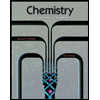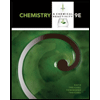
Concept explainers
In the following diagram, the white spheres represent hydrogen atoms and the blue Sphere represent the nitrogen atom.

The two reactants combine to form a single product, ammonia, NH3, which is not shown. Write a balanced chemical equation for the reaction Based on the equation and the contents of the left (reactants) box, how many NH3, molecules should be shown in the right product box?
- 2
- 3
- 4
- 6
- 9
Learn your wayIncludes step-by-step video

Chapter 3 Solutions
Laboratory Experiments For Chemistry: The Central Science, Si Edition
Additional Science Textbook Solutions
Human Anatomy & Physiology (2nd Edition)
Microbiology with Diseases by Body System (5th Edition)
Organic Chemistry (8th Edition)
Anatomy & Physiology (6th Edition)
Campbell Biology: Concepts & Connections (9th Edition)
Biology: Life on Earth with Physiology (11th Edition)
- Indicate the relationship between the activity coefficient YA and the rate constant of a bimolecular reaction in solution k and the rate constant at infinite dilution ko.arrow_forwardDescribe the saline effect that occurs in solutions.arrow_forwardBriefly explain what the infinite dilution rate constant (k∞) consists of.arrow_forward
- The Davies equation corrects the Debye-Hückel limiting law for calculating the activity coefficient of an electrolyte in solution at relatively high concentrations. Mathematically, it is expressed as: log y₁ = -Az²? 1 + √Ĩ - 0,31) Is the formula correct?arrow_forwardDifferentiate between the concepts of "ionic salt effect" and "kinetic salt effect."arrow_forwardDifferentiate the concepts of “salino effect” and “salino kinetic effect”.arrow_forward
- Come and compare the Bronsted-Bjerrum calculation, the Debye and Hückel calculation, and the Davies calculation.arrow_forwardplz watch the youtube video (the title of this topic) by roxi H. she explains it step by step but i get the wrong answerarrow_forwardWriting the rate law implied by a simple mechanism To exit full screen, press and hold esc Suppose the decomposition of ozone proceeds by the following mechanism: step elementary reaction rate constant 1 →>> O3(9) O2(g) + O(g) k₁ 2 03(g) + O(g) → 202(g) k2 Suppose also k₁ »k2. That is, the first step is much faster than the second. Write the balanced chemical equation for the overall chemical reaction: Write the experimentally- observable rate law for the overall chemical reaction. ☐ rate = ☐ Note: your answer should not contain the concentrations of any intermediates. Express the rate constant k for the overall chemical reaction in terms of K1, K2, and (if necessary) the rate constants k-1 and K-2 for the reverse of the two elementary reactions in the mechanism. k = ☐ 000 18 ローロ Ar OOarrow_forward
- Deducing a rate law from the change in concentration over time To exit full screen, press and hold esc A chemistry graduate student is studying the rate of this reaction: H2CO3(aq) → H₂O(aq) +CO₂ (aq) - She fills a reaction vessel with H2CO3 and measures its concentration as the reaction proceeds: time (milliseconds) [H2CO3] 0 0.0500 M 10. 0.0266M 20. 0.0181 M 30. 0.0138M 40. 0.0111 M Use this data to answer the following questions. Write the rate law for this reaction. Calculate the value of the rate constant k. Round your answer to 2 significant digits. Also be sure your answer has the correct unit symbol. rate ☐ x10 k = Х 000 18 Ararrow_forwardWriting the rate law implied by a simple mechanism Suppose the formation of tert-butanol proceeds by the following mechanism: step elementary reaction 1 (CH3)3 CBr(aq) → (CH3)2 C* (aq) + Br (aq) 2 (CH3)2C (aq) + OH¯ (aq) → (CH3)2COH(aq) rate constant k₁ k₂ Suppose also k₁ »k2. That is, the first step is much faster than the second. Write the balanced chemical equation for the overall chemical reaction: Write the experimentally- observable rate law for the overall chemical reaction. Note: your answer should not contain the concentrations of any intermediates. rate = k ☐ Express the rate constant k for the overall chemical reaction in terms of K1, K2, and (if necessary) the rate constants k-1 and K-2 for the reverse of the two elementary reactions in the mechanism. k = ☐ □ ☑ G ? 00. 18 Ar Barrow_forwardDeducing a rate law from the change in concentration over time A chemistry graduate student is studying the rate of this reaction: 2SO3 (g) →>> 2SO2 (g) + O2(g) He fills a reaction vessel with SO3 and measures its concentration as the reaction proceeds: ? time (minutes) [SO3] 0 0.0200M 1.0 0.0105 M 2.0 0.00552M 3.0 0.00290M 4.0 0.00152M Use this data to answer the following questions. Write the rate law for this reaction. rate = k ☐ x10 Calculate the value of the rate constant k. Round your answer to 2 significant digits. Also be sure your answer has the correct unit symbol. k = ☐ Х 000 18 Ar BAarrow_forward
 Chemistry for Engineering StudentsChemistryISBN:9781337398909Author:Lawrence S. Brown, Tom HolmePublisher:Cengage Learning
Chemistry for Engineering StudentsChemistryISBN:9781337398909Author:Lawrence S. Brown, Tom HolmePublisher:Cengage Learning Chemistry for Engineering StudentsChemistryISBN:9781285199023Author:Lawrence S. Brown, Tom HolmePublisher:Cengage Learning
Chemistry for Engineering StudentsChemistryISBN:9781285199023Author:Lawrence S. Brown, Tom HolmePublisher:Cengage Learning Chemistry: The Molecular ScienceChemistryISBN:9781285199047Author:John W. Moore, Conrad L. StanitskiPublisher:Cengage Learning
Chemistry: The Molecular ScienceChemistryISBN:9781285199047Author:John W. Moore, Conrad L. StanitskiPublisher:Cengage Learning ChemistryChemistryISBN:9781305957404Author:Steven S. Zumdahl, Susan A. Zumdahl, Donald J. DeCostePublisher:Cengage Learning
ChemistryChemistryISBN:9781305957404Author:Steven S. Zumdahl, Susan A. Zumdahl, Donald J. DeCostePublisher:Cengage Learning Chemistry & Chemical ReactivityChemistryISBN:9781133949640Author:John C. Kotz, Paul M. Treichel, John Townsend, David TreichelPublisher:Cengage Learning
Chemistry & Chemical ReactivityChemistryISBN:9781133949640Author:John C. Kotz, Paul M. Treichel, John Townsend, David TreichelPublisher:Cengage Learning Chemistry: An Atoms First ApproachChemistryISBN:9781305079243Author:Steven S. Zumdahl, Susan A. ZumdahlPublisher:Cengage Learning
Chemistry: An Atoms First ApproachChemistryISBN:9781305079243Author:Steven S. Zumdahl, Susan A. ZumdahlPublisher:Cengage Learning





